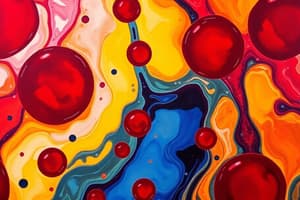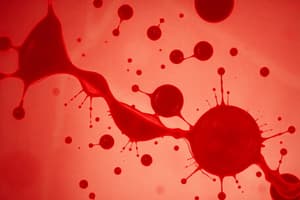Podcast
Questions and Answers
Plasma makes up approximately what percentage of whole blood?
Plasma makes up approximately what percentage of whole blood?
55%
Except for __________, the following statements about blood are true.
Except for __________, the following statements about blood are true.
the pH is slightly acidic
The formed elements of blood consist of what?
The formed elements of blood consist of what?
- White blood cells
- Red blood cells
- All of these are formed elements of blood (correct)
- Platelets
Plasma is closest in composition to what?
Plasma is closest in composition to what?
The percent fraction of formed elements relative to whole blood is the?
The percent fraction of formed elements relative to whole blood is the?
Which of the following is a function of the blood?
Which of the following is a function of the blood?
Which of the following statements about blood is false?
Which of the following statements about blood is false?
Formed elements make up about what percentage of blood?
Formed elements make up about what percentage of blood?
The combination of plasma and formed elements is called?
The combination of plasma and formed elements is called?
Whole blood for testing in a clinical laboratory is usually collected from?
Whole blood for testing in a clinical laboratory is usually collected from?
When checking the efficiency of gas exchange, it may be necessary to draw a blood sample from?
When checking the efficiency of gas exchange, it may be necessary to draw a blood sample from?
Consider these results from a blood lab test. Which value is most likely abnormal?
Consider these results from a blood lab test. Which value is most likely abnormal?
Each of the following is a characteristic of whole blood, except a?
Each of the following is a characteristic of whole blood, except a?
The total volume of blood in the body of a 76-kg man is approximately how many liters?
The total volume of blood in the body of a 76-kg man is approximately how many liters?
The most abundant component of plasma is?
The most abundant component of plasma is?
A person who has a low blood volume is said to be?
A person who has a low blood volume is said to be?
The chief difference between plasma and interstitial fluid involves the?
The chief difference between plasma and interstitial fluid involves the?
A typical adult hematocrit is?
A typical adult hematocrit is?
Which of these is not one of the formed elements of blood?
Which of these is not one of the formed elements of blood?
Plasma composes about ________ percent of whole blood and water composes ________ percent of the plasma volume.
Plasma composes about ________ percent of whole blood and water composes ________ percent of the plasma volume.
A hematocrit provides information on?
A hematocrit provides information on?
You are caring for an adult patient who weighs 48 kg. What would her approximate blood volume be?
You are caring for an adult patient who weighs 48 kg. What would her approximate blood volume be?
Serum can't coagulate because the __________ has been removed.
Serum can't coagulate because the __________ has been removed.
Except for the amount of __________, plasma and interstitial fluid differ little in composition.
Except for the amount of __________, plasma and interstitial fluid differ little in composition.
The most abundant solute (by mass) in plasma is __________.
The most abundant solute (by mass) in plasma is __________.
Thyroid-binding globulin is an example of which kind of plasma protein?
Thyroid-binding globulin is an example of which kind of plasma protein?
Transferrin is an example of which kind of plasma protein?
Transferrin is an example of which kind of plasma protein?
Which plasma protein transports fatty acids and some hormones?
Which plasma protein transports fatty acids and some hormones?
Which organ secretes most of the plasma proteins?
Which organ secretes most of the plasma proteins?
The most abundant proteins in blood plasma are?
The most abundant proteins in blood plasma are?
Plasma proteins essential in body defense are the?
Plasma proteins essential in body defense are the?
A plasma protein essential for blood coagulation is?
A plasma protein essential for blood coagulation is?
The formed elements are largely produced within the __________.
The formed elements are largely produced within the __________.
Flashcards
Plasma
Plasma
The liquid portion of blood, comprising approximately 55% of its volume.
Formed Elements
Formed Elements
The cellular components of blood, including red blood cells, white blood cells, and platelets, making up about 45% of blood.
Hematocrit
Hematocrit
A measure of the percentage of formed elements (red blood cells, white blood cells, and platelets) in whole blood, typically around 45%.
Blood Volume
Blood Volume
Signup and view all the flashcards
Blood Viscosity
Blood Viscosity
Signup and view all the flashcards
Blood pH
Blood pH
Signup and view all the flashcards
Blood Color
Blood Color
Signup and view all the flashcards
Gas Transport
Gas Transport
Signup and view all the flashcards
Defense Against Toxins and Pathogens
Defense Against Toxins and Pathogens
Signup and view all the flashcards
Nutrient Transport
Nutrient Transport
Signup and view all the flashcards
Waste Transport
Waste Transport
Signup and view all the flashcards
Temperature Regulation
Temperature Regulation
Signup and view all the flashcards
Coagulation
Coagulation
Signup and view all the flashcards
Arterial Blood Sample
Arterial Blood Sample
Signup and view all the flashcards
Venous Blood Sample
Venous Blood Sample
Signup and view all the flashcards
Plasma
Plasma
Signup and view all the flashcards
Interstitial Fluid
Interstitial Fluid
Signup and view all the flashcards
Plasma Proteins
Plasma Proteins
Signup and view all the flashcards
Fibrinogen
Fibrinogen
Signup and view all the flashcards
Immunoglobulins
Immunoglobulins
Signup and view all the flashcards
Albumins
Albumins
Signup and view all the flashcards
Thyroid-Binding Globulin
Thyroid-Binding Globulin
Signup and view all the flashcards
Transferrin
Transferrin
Signup and view all the flashcards
Red Bone Marrow
Red Bone Marrow
Signup and view all the flashcards
Serum
Serum
Signup and view all the flashcards
Buffers
Buffers
Signup and view all the flashcards
Study Notes
Blood Composition
- Plasma comprises approximately 55% of whole blood.
- Formed elements include red blood cells, white blood cells, and platelets, collectively making up about 45% of blood.
Blood Properties
- Blood is more viscous than water; its viscosity is three to five times greater.
- The normal pH of blood ranges from 7.35 to 7.45.
- Blood temperature is approximately 38 degrees Celsius and has a deep red color due to hemoglobin.
Blood Functions
- Blood functions include:
- Transporting gases (oxygen and carbon dioxide).
- Defending against toxins and pathogens.
- Transporting nutrients and wastes.
- Regulating body temperature.
Hematocrit and Blood Volume
- Hematocrit measures the percent fraction of formed elements relative to whole blood, typically around 45%.
- A 76-kg man has a total blood volume of approximately 5.3 liters, while an adult weighing 48 kg would have about 3.8 liters.
Blood Testing
- Whole blood for testing is usually collected from superficial veins.
- Arterial blood samples may be drawn to assess gas exchange efficiency.
- An abnormal hemoglobin level is indicated at 10.7 g/100 ml.
Plasma and Interstitial Fluid
- Plasma composition closely resembles interstitial fluid, differing mainly in protein concentration (plasma has higher protein levels).
- Water makes up about 92% of plasma volume, while proteins are the most abundant solute in plasma.
Plasma Proteins
- Major plasma proteins include:
- Albumins: transport fatty acids and hormones.
- Immunoglobulins: essential for body defense.
- Fibrinogen: crucial for blood coagulation.
- Thyroid-binding globulin: a hormone-binding protein.
- Transferrin: a metalloprotein that transports iron.
Production of Formed Elements
- Formed elements are largely produced in the red bone marrow.
- Antibodies are not considered formed elements of blood.
Serum and Coagulation
- Serum lacks the coagulating factor fibrinogen, which is essential for clotting processes.
Summary of Blood Characteristics
- Normal blood pH is maintained by buffers.
- Blood contains dissolved gases, proteins, and nutrients necessary for various body functions.
Studying That Suits You
Use AI to generate personalized quizzes and flashcards to suit your learning preferences.




